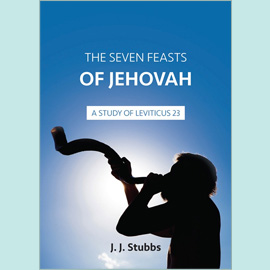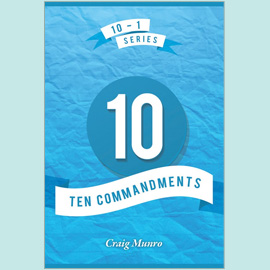Prophecy was back in the secular news recently when in October 2014 a new film version of the Left Behind series was released. Because film studios aim for box office success rather than Biblical accuracy, the informed Christian will wish to derive his understanding of God's programme for the earth from a careful tour of Scripture rather than a trip to the cinema. If, then, you have never looked at it closely before, may I suggest that in 2015 you take the plunge and get to grips with the book of Revelation? Many find it obscure and frightening, and so keep their distance. Calvin famously did not write a commentary on it. Well, its place at the close of the canon certainly signals that we need to be well-read in the rest of Scripture to make the most of it. And that's yet another good reason for making sure we are constantly devouring the whole Bible! The following introduction offers a simple guide to what is, in reality, one of the most exciting and encouraging parts of God's Word.
The first thing to grasp is that the source of the book is not wild human speculation but divine revelation. Revelation is just as much inspired of God as John's Gospel – indeed, it was penned by the same man. The apostle was granted a unique unveiling of future events which came from the Lord Jesus (Rev 1.1; 22.16), with the spotlight cast upon His coming glory (Rev 1.7). Its presiding subject is therefore Christ Himself. Previewing future happenings on this earth ("things which must shortly come to pass", Rev 1.1), it unfolds the culmination of God's plan for the universe, a plan "to head up all things in the Christ, the things in the heavens and the things upon the earth; in him" (Eph 1.10, JND), "that he might have the first place in all things" (Col 1.18, JND). Believers can rejoice that Christ will conquer!
Despite its reputation for difficulty, the book's structure is on the whole very simple. After a brief prologue (Rev 1.1-8), Revelation falls into three sections of unequal length which trace the history of God's dealings with men from John's time right through to the eternal state. The key to unlocking its design is found in 1.19: "Write therefore what thou hast seen, and the things that are, and the things that are about to be after these" (JND). Notice the three parts of that verse. John is told to write about
• The Christ (1.9-20): what thou hast seen (past) – a portrait of the glorified Lord as seen by John
• The Churches (2-3): the things that are (present) – a survey of local church testimony in this world
• The Consummation (4.1–22.5): the things that are about to be after these (future) – a foreview of global judgment and final blessing.
The epilogue (Rev 22.6-21) includes a glowing triple promise of the Lord's return calculated to cheer the heart, and a solemn warning not to tamper with the words of the book.
The first section, with its vision of the exalted Christ, teaches us that only as we contemplate the risen Lord can we face the future. The second sums up local assembly features during the present era, stretching from the inauguration of the body of Christ at Pentecost to its removal at the rapture. The third section starts with a glimpse of enthroned saints worshipping in heaven, and then describes the seven year tribulation period on earth preceding the inauguration of the Kingdom. The book is as orderly and coherent as God's programme.
It is important to notice that the events leading up to the millennium flow in chronological sequence. However, the chapters recording this sequence are interspersed with interludes which suspend the forward movement in order to look in depth at key events or persons. Chapter six, for example, catalogues the judgments unloosed at the breaking of the first six seals, while chapter seven pauses to answer the question raised in 6.17 by showing God's grace at work in preserving a remnant of Jewish servants on earth and a vast host of believers in heaven. Any who doubt the sequential movement of the book should consult Gary Cohen's excellent Understanding Revelation (Wipf & Stock, 1992).
But someone is bound to ask how an ordinary believer can make sense of a book packed with symbolism. Well, let's note that right at the start the book offers an inducement: "Blessed is he that readeth, and they that hear the words of this prophecy, and keep those things which are written therein" (Rev 1.3). How many books promise that? God rewards all who respond positively to His Word. And symbolic language need be neither incomprehensible nor irrational. All metaphors and symbols have a literal meaning, which is often explained by the context (Rev 1.20; 12.9), or by consulting earlier Scriptures (Rev 12.1; Gen 37.9-10). The horrifying judgments unleashed on the earth via seals, trumpets and vials need not be allegorized away, any more than the Noahic flood, the destruction of Sodom, or the plagues of Egypt should be robbed of their plain meaning. And yet some fine commentators have been reluctant to let Scripture speak for itself. About the first trumpet judgment, where we read "the third part of trees was burnt up, and all green grass was burnt up" (Rev 8.7), William Kelly writes, "this evidently does not refer to the literal earth, trees or herbage". But why ever not? What God did historically on a small scale in Egypt He will evidently do on a global scale in the tribulation. All calls to "save the planet" are therefore doomed to failure, for God is going to waste the very earth which men foolishly worship. It's safest to take words in their natural sense, just as we should take numbers and time references at face value (four living creatures, seven seals, 24 elders, 144,000 sealed Israelites, two witnesses, 42 months, 1,000 years). If Scripture doesn't mean what it says, how can we hope to know what it's about? The moment we abandon the literal sense, we are adrift in a sea of indeterminacy where no two interpreters think alike.
What about the scope of the book? It supplies graphic information about what lies ahead. We trace the preservation of a Jewish remnant on the earth, the outpourings of divine anger upon the ungodly, the unwillingness of men to repent despite unprecedented signs and wonders, the rise and fall of two wicked world leaders, the battle of Armageddon when Christ defeats all His enemies, the imprisonment of Satan, the resurrection of tribulation martyrs and Old Testament saints, the reign of Christ on the earth for 1,000 years, a brief post-millennial rebellion put down by fire, the Great White Throne judgment of the dead, and the new heavens and earth. God doesn't want His people to be in the dark about His glorious programme. The grand anticipation is Christ's public return and reign (Rev 1.7), for everything paves the way for the stupendous coming of the Lord Jesus with His saints (Rev 19.11-14). This assured triumph should cause us to look all the more for the coming of the Lord for His saints (1 Thess 4.13-18), to snatch them away from the devastating judgments of the tribulation, for our privilege is to "await [God's] Son from the heavens, whom he raised from among the dead, Jesus, our deliverer from the coming wrath" (1 Thess 1.10, JND). Again, the whole book forms a powerful validation of the Saviour's promise that the Holy Spirit would reveal to the apostles "things to come" (Jn 16.13). The Lord Jesus, "Faithful and True" (Rev 19.11), can be trusted. Finally, it's a positive stimulation to godly living in tough times, for Biblical prophecy is always practical. Though church age believers will not pass through the terrible furnace of the tribulation, we nonetheless face real trials in this world (Jn 16.33; Acts 14.22), and the assurance of the Saviour's victory encourages us to keep going. See if you can find the seven bracing beatitudes that thread through the book. But don't leave your study of Revelation too late. It's well worth reading the Apocalypse now!
To be continued.









